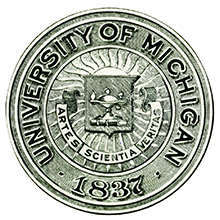Well, it was re-started then. But the assets and records of the old University of Michigania were turned over to the new regents – a link to the old school in Detroit that would be remembered only much later.
Thanks to a financial slump that hit the western states especially hard, it took four more years to construct buildings, hire professors and, finally, to admit some students.
But for many decades, 1837 was considered the University’s founding year – especially in Ann Arbor, which was proud of its growing claim to fame and happy to promote itself as the University’s one and only home.
And “1837″ was placed on the University’s official seal.




